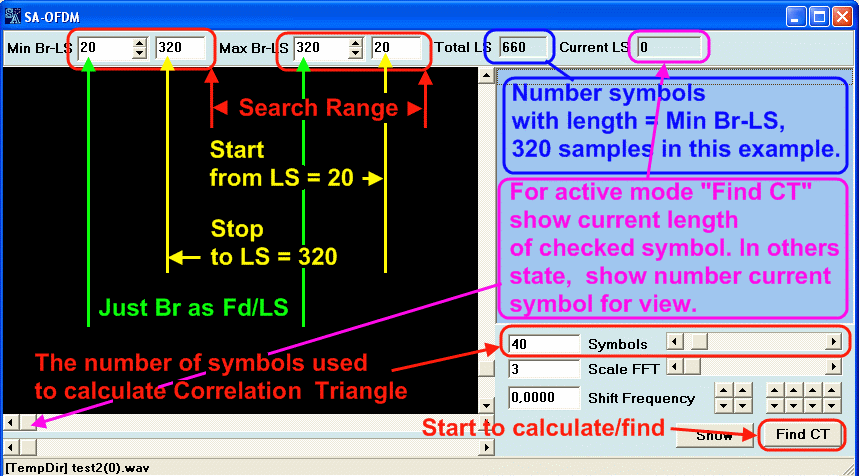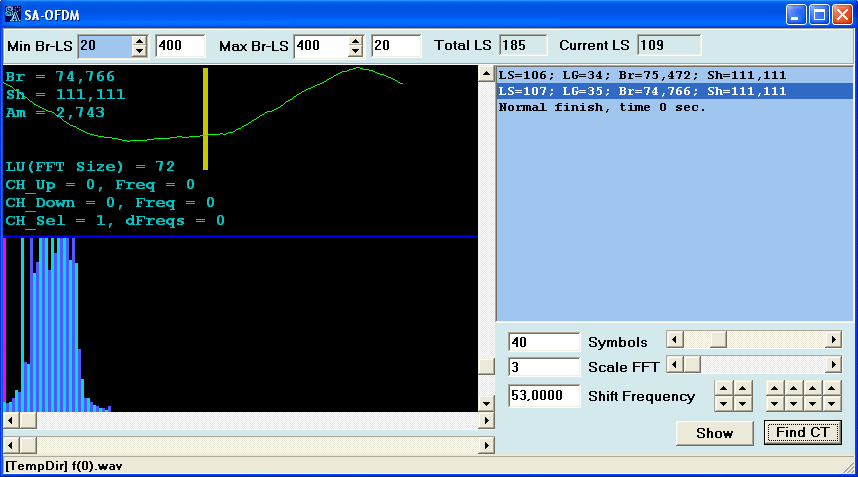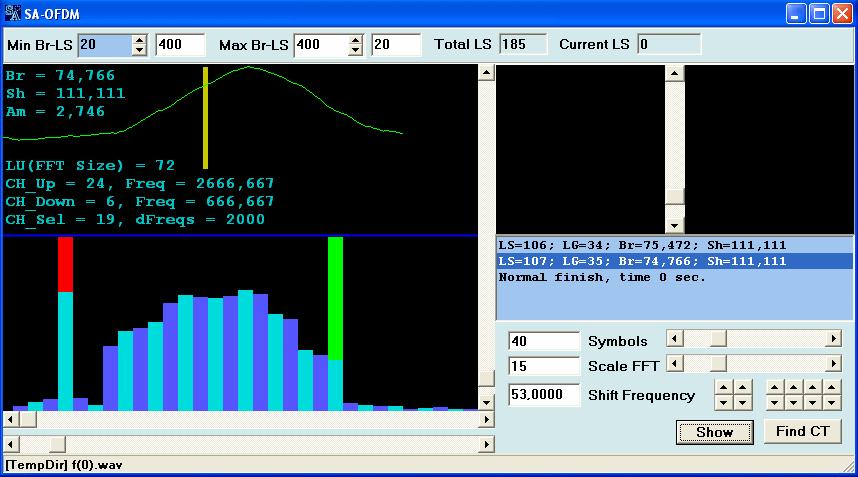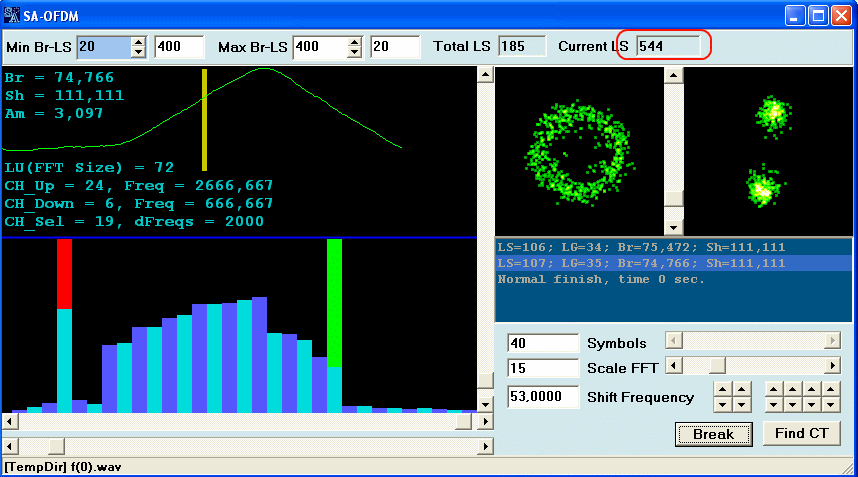|
|
| Разместил (Author): |
SergUA6  |
| Авторские права |
© http://www.radioscanner.ru |
|
|
Текст
|
OFDM analysis module in SA version v 6.1.2.5
The main difference of the current version from previous ones, is the presence of the extremely effective clock/symbol synchronization, and as consequence, possibility to view dedicated/selected channel in dynamics.
Let's consider module elements in more details.

The first step in analysis OFDM, is the search of a correlative triangle.
There are only free key parameters for search of a correlative traingle:
These are:
- The Min Br-LS field, search lower bound
- The Max Br-LS field, search higher bound
- The Symbols field, quantity of characters/symbols end result is averaging out
Search is carried on from the higher bound to the lower bound, as the required/assumed result is located in range, and speed of calculations is strongly reduced at increasing of the symbol's length.
The symbol's length is directly linked to clock frequency OFDM, Br = Fd/LS. Where Fd - is sampling rate of creation of a signal or record.
It is better to set boundaries of search as value Br, but keep in mind that only the whole values are admissible. It means, if we want that 56.625 value Hz would be precisely counted, it is necessary to expose value 55 in the lower bound, or put 54 would be even better.
It is desirable to narrow down boundaries of search from above as well. Although the higher bound has no special value, because on short lengths speed of calculations is rather high. Nevertheless, on big sampling rates it is necessary to adjust it.
The quantity of symbols used in calculation at searches of a correlative triangle has the great importance only on short records, in those cases, when the value of Symbols field is essentially lower 40.
By default the program tries to expose this value in 40 symbols. But as, in attention taken only the lower bound (as the most expected/investigated symbol), then frequently on the short records it becomes impossible, then this value is lesser then 40, that indirectly speaks, about possibility to get not fully correct results.
In general, using of fixed quantity of symbols for an averaging-out can't be admitted as the correct solution, because, for the short LS and short CP, more symbols are required than for long LS and long CP. But these are questions of future optimizations.
By default, the program exposes a lower bound proceeding from sampling rate. The higher sampling rate, the higher lower bound. Seldom enough we can meet OFDM signals with clock frequency below 20 Hz.
As it was already spoken many times, analysis is the complex the task, and if there is a possibility to receive preliminary parameters of the researched signal through the classical analysis, it is necessary to do it. Frequently, it sharply reduces time for finding of a correlative triangle, at the expense of reduction of boundaries of search.
For an example, we will take signal MIL-STD-188-110A 16 Channels
After selection by vertical markers of a fragment of the signal in working window SA, we call OFDM module, and leaving default settings, we start the program of triangle searches.

Approximately in 1-2 seconds the triangle will be found, and the program can be stopped. If calculations will not be interrupted, searches of triangle will be continued until the lower bound, this will take much more time, and most likely more candidates on "triangle" will be found. If we would receive preliminary clock frequency, through the classical analysis (on this signal it can be easily defined through ADP function) then we would avoid superfluous loss of time and superfluous results.
It can be considered as advantage of the preliminary classical analysis.
As we can see, the triangle is negative, and it’s polarity should be changed. It can be realized through Shift Frequency. It is possible to make shift in any side, but it is better to do it in that side, at which the amplitude of the negative triangle will decrease, as the necessary positive maximum in this case is closer. It is necessary to mark, that it is not fully correct method, and the result can have no single meaning.

After signal's shift by frequency is done, recalculation of a triangle for the purpose of specification of parameters is necessary. Because the previous results are concerned to another signal, which has been not shifted. In this version, repeated recalculation is spent only for those values LS and LG, which are selected in the text box, it raises efficiency and allows to avoid superfluous expenses of time.
However, at any time complete recalculation "from zero" can be demanded, the reasons can be vary. How to be in this case? It is necessary to select string where LS and LG are not present, such string is always exists and it is the last string. Selection of this string, means that it is required to start searches of a correlative triangle from zero. As in our situation we do not need to start searches from zero, we do fast recalculation.

Fast recalculation leaves one-three results, and deletes all received earlier intermediate results.
Now we only need:
1) to select scale of FFT spectrum for convenient observation
2) to put the yellow marker on "the good" side of triangle,
3) to switch on phase planes
4) to select the channel for observation/studying
5) to start process of mapping by button "Show".
Approximately so everything should look before start "Show", for observation the uppermost channel is selected.

There are some details. The selected channel marked with green or violet marker (if both markers are combined), should be in the window of mapping of a spectrum. As it is possible to move and scale the spectrum, there is also possibility to output the marked channel behind window limits. If such situation arises, then there will not be any constellations. The program ignores channels which are not visible on the screen.
There are still some things, which need to be known.
The field "Current LS" is the field of double assignment. In the mode of search of a correlative triangle, this field mirrors the current length LS, which it is checked. In the signal browse mode, it mirrors number of the current symbol, which it is output on FFT spectrum. Number naturally concerns to the fragment of the signal loaded in the module by its call.
Before we will start automatic process of mapping, I suggest to make some steps in a hand-held mode, it will be well visible how the triangle intensively enough "leaves" aside and sooner or later will leave the marker.

Approximately through 50-60 steps, "the good" side of triangle, in general, will leave from marker, and FFT spectrum will be transformed beyond recognition, it means that the symbol is completely lost. Now, it is possible to return a slider in the beginning, to expose the yellow marker in the necessary position, and to start process of mapping of constellation in dynamics.

As we see, total quantity of the symbols in the fragment is about 540, the triangle has not moved anywhere, and relative constellation more than stable and pure, as clock/symbolical synchronization works.
Dynamic mapping from the symbol (which is displayed before beginning (Current LS floor)) starts. That is, it should not be only the null symbol, it is possible to take any other symbol, sometimes it is useful. The program will not start, if there are less than 10 symbols, such situation is possible, when the positioning of the slider by a fragment is installed in the end, or the record is very short.

There are two ways to solve this problem:
1) if the fragment is long enough, it is necessary to move the positioning slider in earlier position
2) If the fragment is short, and the slider already situated in the beginning of the fragment, then it is necessary to reduce quantity of symbols in the field Symbols.
It is not recommended to reduce quantity of symbols lesser than 6. Because clock synchronization spends an averaging out by this quantity, and though the algorithm is effective, smaller values are fraught with synchronization failures.
Of course an including of clock synchronization is the necessary component for the qualitative OFDM analysis, but it does not solve the main questions of reception of exact parameters of a signal. We still are working in this direction, although we are moving not so fast as it would be desirable we are close enough to the purpose.
Good luck~
|
|
|
|
Добавлять комментарии могут только зарегистрированные, активировавшие регистрацию и не ограниченные в доступе участники сайта!
|
| Файл создан: 20 May 2010 23:06, посл. исправление: 23 May 2010 00:10 |
|

